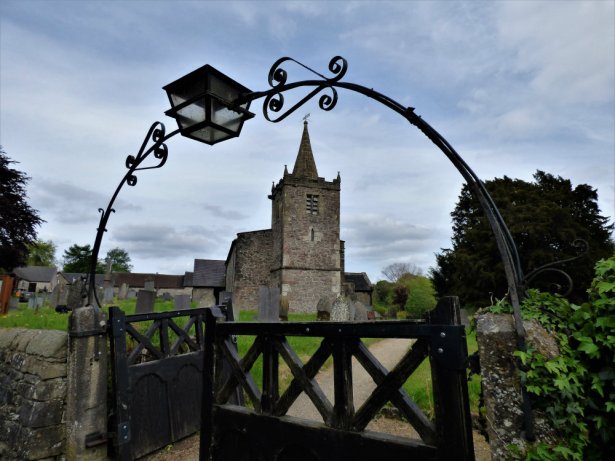
On my last trip north, I took a different route, and that is always an adventure. With never enough time to take side-trips and explore, I can never resist when something just drops in my path, so when, after three hours driving, a village that announced itself as a Saxon settlement offered me a church and a parking spot, the inevitable happened. I pulled over and grabbed the camera.
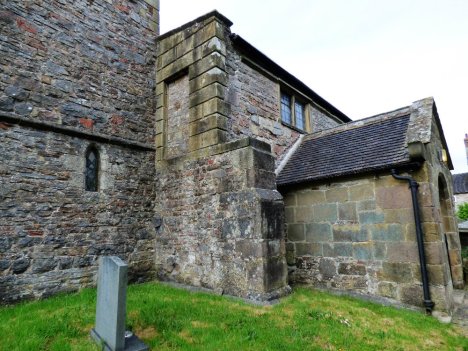
Even from the road it is an interesting little church. You can see its architectural evolution in the different styles and the shapes and colours of the stonework. It stands in the shadow of a thousand year old yew, it is built on a small mound in the centre of the village and a newborn stream runs around its base…a perfect situation for an ancient place of worship that may even pre-date this church and the present building already goes back nine hundred years.
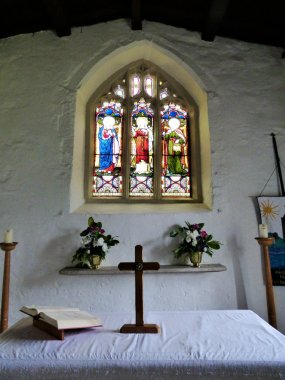
The human story of the village goes back much further. The surrounding hills are dotted with archaeological sites and, in the nineteenth century, antiquarian Thomas Bateman excavated one of the Stand Low round barrows here, bringing to light a bronze dagger, a stone axe, a pottery urn and an amber ring.
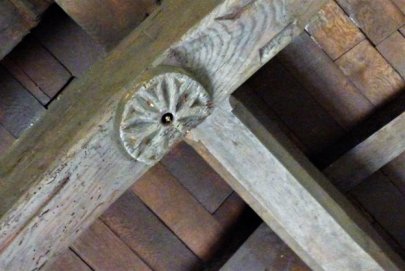
The name of the village is said, by those who should know, to be derived from the Old English for a farm belonging to a woman named Cengifu. I am not always convinced by these attributions as personal names and wonder if linguists do not decide upon them simply because they don’t want to admit they don’t really know the meaning.
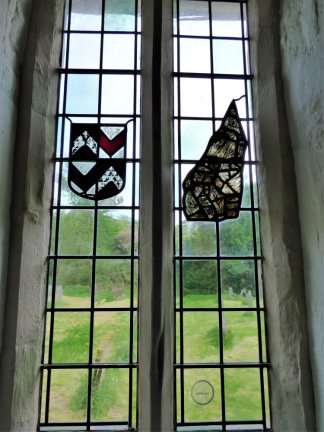
The village was already well established and its name had evolved at the time of the Norman Conquest, and when the Domesday Book was compiled in 1086, it was listed as Cheniveton. The manor belonged to the Kniveton family until Sir Andrew Kniveton, a staunch Royalist during the Civil War, was obliged to sell the land in the middle of the seventeenth century to pay the heavy fines imposed by Cromwell’s victorious Roundheads. The Kniveton arms can still be seen within the church as a panel of fifteenth century stained glass, along with an even older fragment from the fourteenth century.
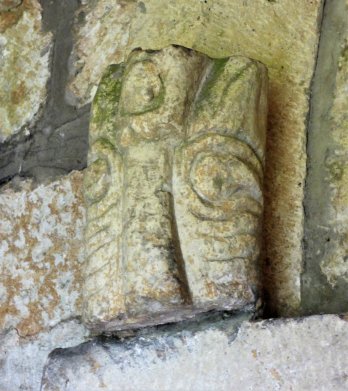
The old door of the church is set beneath a plain Norman arch, with a human head as its keystone that is sometimes described as a bear. The supporting corbels are also carved… one is now too worn to identify, but the other is a ‘beaked head’ which looks rather draconine.
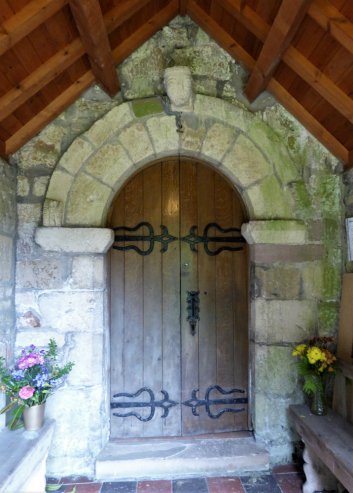
It is always exciting to turn the handle on these old doors, wondering whether or not they will open and, if they do, what you might find within. This time, the door swung inwards and I stepped into the happiest church I have ever felt. And that is strange, for churches may be lovely, welcoming or forbidding, serene and peaceful or even cold and stark… but I have never found one that simply felt happy. I wondered why…
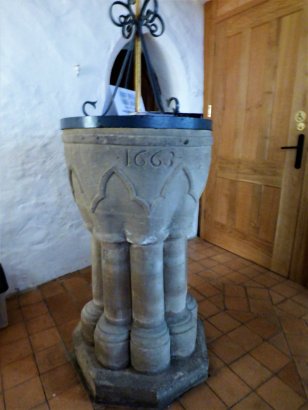
My first impressions revealed nothing to explain it. St Michael and All Angels is a simple, single-cell building with a later gallery and thirteenth century tower, contemporary with the font which, though it carries a seventeenth century date, is Early English in style and also dates to the thirteenth century. The carved date commemorates a renovation of the church which had been built originally, some nine hundred years ago, as a chapelry for the Church of St Oswald in nearby Ashbourne. At that time it was dedicated to St John the Baptist and I wondered if it was his head that was carved into the arch of the doorway… and, if so, why it would be mistaken for a bear.
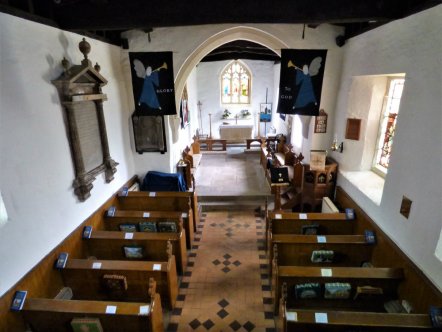
Behind the font a narrow staircase winds up to the gallery, passing the temptation of the bell ropes that have been calling worshippers to prayer for the last four hundred years. From the gallery you can see the whole body of the church and I could pinpoint nothing to explain why the place felt so cheerful.
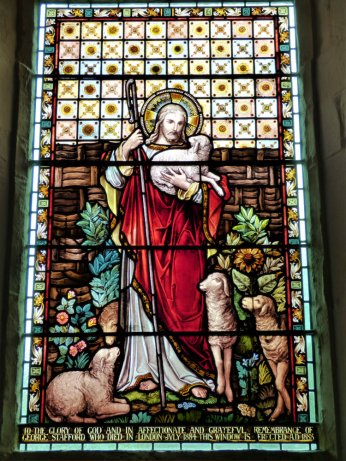
There is some really beautiful Victorian and Edwardian stained glass, though, with jewel colours glowing in the low sun.
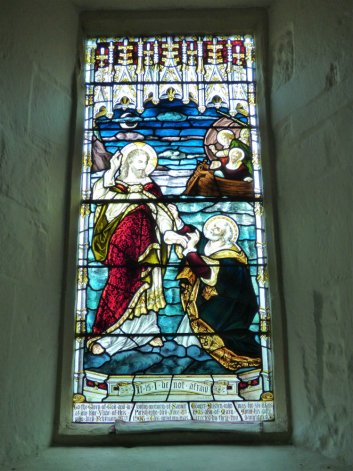
They are mostly commemorative pieces, as are so many stained glass windows, in memory of parishioners and clergy alike, including the east window, a tribute to a mother from her children, which shows Jesus between the Virgin Mary and Joseph carrying a cage of doves.
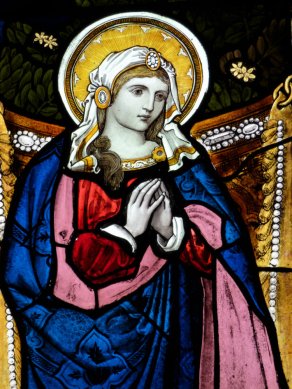
My favourite was the one that shows Faith, Hope and Charity. A little different in style and rather more simple, it dates from 1908 and is a tribute to a former vicar and his wife.
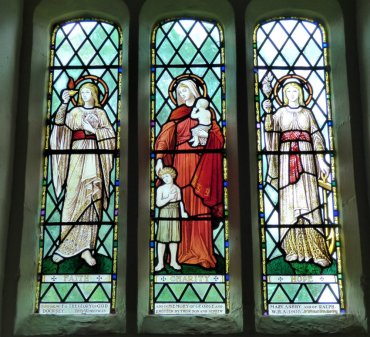
There was evidence of much love in the windows, but I still couldn’t see any reason why the place should feel so happy. There were embroideries and hanging made by the local children, so it was evidently a church still very much at the heart of its community.
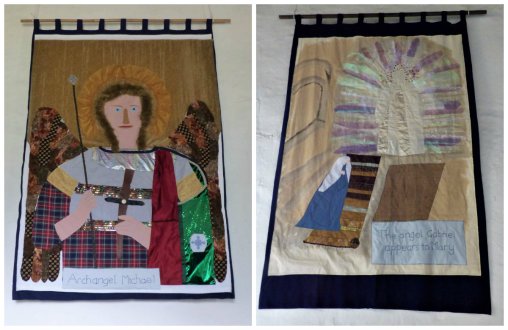
There were flowers everywhere, and that always helps. There were fresh bouquets behind the altar, ancient floral geometries carved as ceiling bosses, and painted, arts and crafts style, on the pulpit. There were also flowers carved into the bench-ends of the ‘new’ pews, installed in 1842.
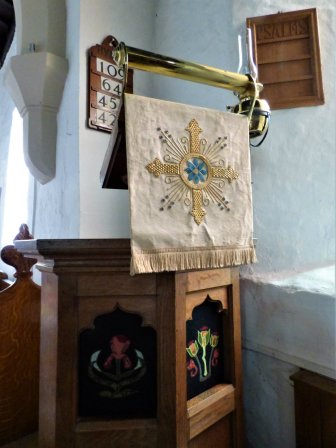
And not just flowers…
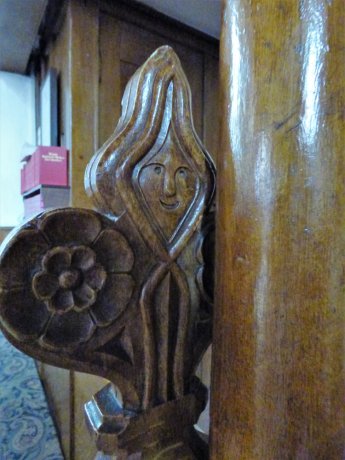
Half the bench-ends were carved with foliate men.Green Men, nature spirits, or in Christian iconography, symbols of resurrection and rebirth. And all of them were smiling… and they were not on their own. I couldn’t help smiling back.
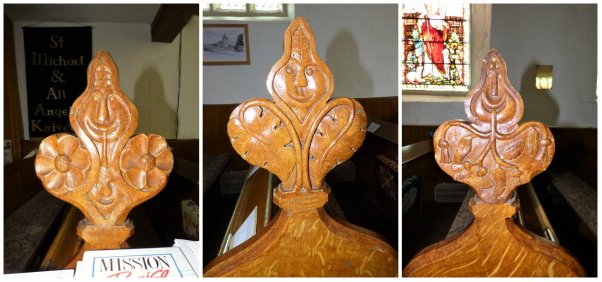
There was another smile too. When the new pews were being installed, a carved stone was found. No record exists of where in the church it was originally placed, and there is no mention of its age. They set the roundel into the south wall of the nave for safekeeping where it could easily be overlooked, and that would be a shame. It is old, seems, at first glance to be crudely carved and ‘primitive’ in style. It is possibly as old as the church itself… and it is possibly the most beautiful crucifix I have seen.
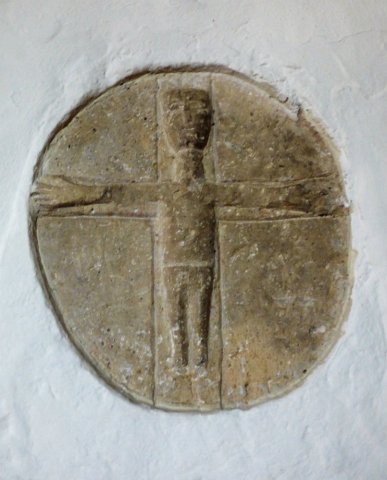
Although depicted on the Cross, He smiles. His arms are outstretched as if to embrace the world in simple joy and acceptance, with neither judgement nor discrimination. It is as if, in this one simple carving, the artist has transcended the dogma and politics of ‘churchianity’ and cut straight to the heart of the message of Love. I find I cannot argue with that.
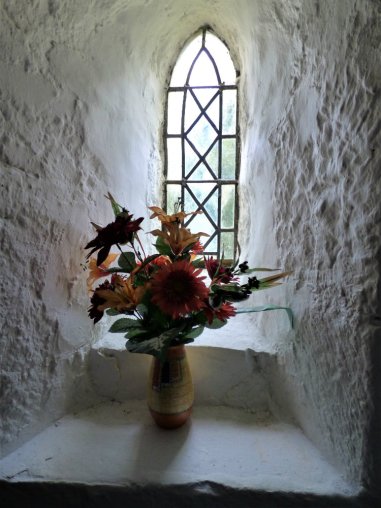









































Well it made me smile, just from your photos, a lovely church and that crucifix is amazing. I think you are right about it being as old as the church, there are smilier crosses in Scotland that are 10th century…..a really treasure. Glad you stopped for a look 🙂
LikeLiked by 1 person
The style is very similar to carvings from that date, I agree. I am glad I stopped too 🙂
LikeLiked by 1 person
It’s amazing what you can find in country churches 🙂
LikeLike
That’s why I love exploring them…and unlike a museum, this is still living history in the making 🙂
LikeLiked by 1 person
Yes that is their charm, and everyone is different. just wish more people realised it and took an interest them 🙂
LikeLike
Yes, they are such an important part of our soial and artistic history.
LikeLiked by 1 person
Hopefully we both get more people interested in them, through blogging about them…..well I like to think so 🙂
LikeLike
I hope so too, Lynne, and I know a few people have wandered off in search of a church after reading 🙂
LikeLiked by 1 person
Fingers crossed more will follow 🙂
LikeLike
Amen to that. It is by attracting visitors that many of these old churches are kept alive.
LikeLiked by 1 person
Mind you it would help if you could get into some of them 🙂
LikeLike
Especially the urban ones… 😉
LikeLiked by 1 person
Yes 🙂
LikeLiked by 1 person
Hi, next time you are in the area take time to see the other 4 Churches. Reverend Phil Mitchell is the Vicar in charge known by Bradley school kids as Rev. Phil (he is good with the kids). Carry on past Kniveton and take the turn for Hognaston. What a beautiful church the first time I have ever been in was this Sunday past. Carry on then to Atlow church, next is Hulland and finally Bradley off the A 517. I just took some visitors from the USA they loved them all. You can even take a picnic with you as you will already have seen it is a beautiful area. Regards Val.
LikeLike
If I get chance, Val, I certainly will…thank you! Isn’t the church at Hognaston the one with the carved tympanum over the door?
LikeLike
I love this little church. The smiles, the flowers, the signs of children, the brightness, all make this a happy place. Not the gloomy atmosphere of many churches. What a great find. I´m sure you are pleased that you stopped.
LikeLiked by 1 person
It is the least sombre of places, Darlene… a really lovely church 🙂
LikeLiked by 1 person
I can’t tell you how much I enjoyed this post. Thank you for sharing your smiling church!
LikeLiked by 1 person
I really enjoyed this impromtu visit myself. It left me smiling 🙂
LikeLike
Reblogged this on Sun in Gemini and commented:
From Sue, with ‘love’…
LikeLiked by 1 person
I think you have already answered the question; the church is happy because it is still loved and a living church. Perhaps the parisheners have always been a happy lot, from the stone ‘happy crucifix’, the green men on the pews to the children’s wall hangings. Also the church looks bright with its white walls.
LikeLiked by 2 people
A lovely, happy little church – thanks for sharing your visit to it. I like the smiling Green Men – sometimes they can be forbidding and unsettling. These ones are lovely.
LikeLiked by 1 person
I don’t think I have ever seen any quite as cheerful as these 🙂
LikeLike
Reblogged this on DENIS LEVIEUX PHOTOGRAPHE INFOGRAPHISTE.
LikeLiked by 1 person
Mercie beaucoup 🙂
LikeLike
how charming – no wonder it is happy –
LikeLiked by 1 person
It can’t help itself 🙂
LikeLike
Lovely, Sue!
LikeLiked by 1 person
Isn’t it? 🙂
LikeLike
Thank you for the tour with beautiful images.
LikeLiked by 1 person
I am glad you enjoyed it 🙂
LikeLike
Reblogged this on Viv Drewa – The Owl Lady.
LikeLiked by 1 person
Thank you, Viv xxx 🙂
LikeLiked by 1 person
You’re very welcome, Sue!
Hugz on owl wings! @v@ ❤
LikeLike
Hugs bac, Viv xxx
LikeLike
Pingback: Kniveton – The little church that smiled – The Militant Negro™
Thanks for sharing 🙂
LikeLike
What a beautiful little church, Sue. Thanks for sharing it with it. It is a happy one, isn’t it? What a lovely find for the road…
LikeLiked by 1 person
It was a fabulous little place, Dale… I am so glad I stopped 🙂
LikeLiked by 1 person
A church only gives the feeling that is apparent in these photos if the people in charge of it are also loving and caring, and dedicated to keeping it alive. The fact that the little artworks of children are given a prominent place for display is evidence that the person or persons who were responsible for caring for the church and its community were truly loving and open spiritually to different forms of demonstrating one’s image of what faith means or meant, and also it shows a tremendous respect and love for its community, something that is somewhat absent in many of the churches today. It truly provided a spiritual home for the old and young alike. Would that love were the center of all churches today.
LikeLiked by 1 person
That was the impression I got, Anne… and I think therehas been that same love and care for the community through many ages here.
LikeLike
Lovely, Sue!
LikeLiked by 1 person
Thanks, Traci xx
LikeLiked by 1 person
You’re welcome, Sue!
LikeLiked by 1 person
I love that you sensed the ‘happy’ right away and found the reason eventually. A neat little church!
LikeLiked by 1 person
It’s lovely. Maybe I noticed the bench-ends subconciously, but you really couldn’t miss the happy feeling 🙂
LikeLiked by 1 person
What a wonderful place. And you are right. Something interesting to shoot and a safe place to park … who could resist? The church seems to be in amazingly good shape. Just absolutely lover and the smiling Christ is truly transcendent.
LikeLiked by 1 person
I certainly couldn’t. 🙂 The place seems gently cared for and the carvings just made my day 🙂
LikeLike
Lovely post Sue.. xxx
LikeLiked by 1 person
Thanks, Sally xx
LikeLiked by 1 person
Wonderful. Just wonderful!
LikeLiked by 1 person
It’s a lovely place, Jennie 🙂
LikeLiked by 1 person
🙂
LikeLiked by 1 person
Thank you for visiting and liking our church: we are very proud of it. Come back in November to see our Angel Festival!
LikeLike
I would love to June… it is a really lovely church and I felt very welcome there.
LikeLike
Pingback: A Thousand Miles of History: Under one roof… – France & Vincent